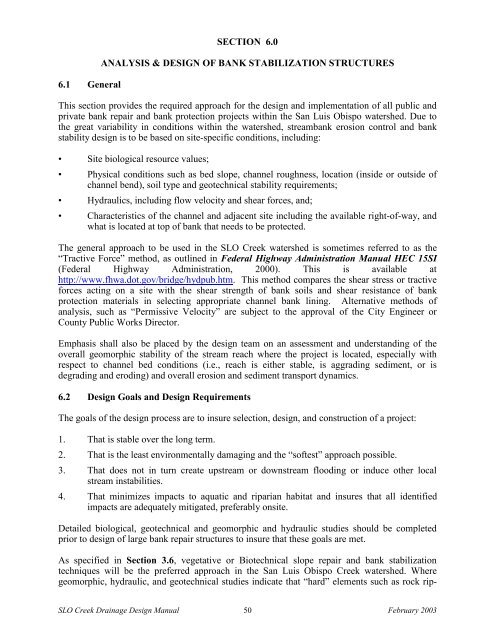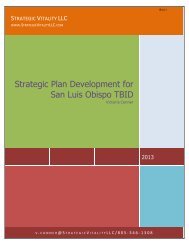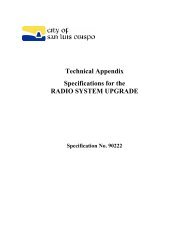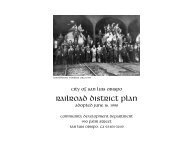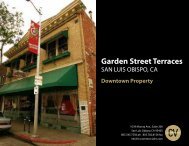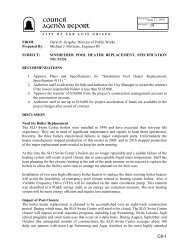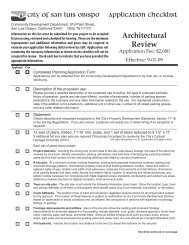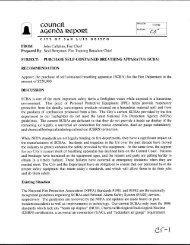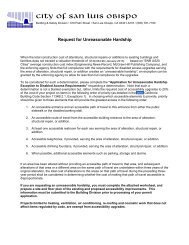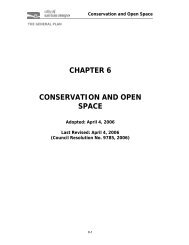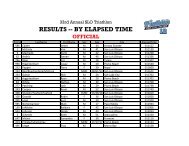Drainage Design Manual - the City of San Luis Obispo
Drainage Design Manual - the City of San Luis Obispo
Drainage Design Manual - the City of San Luis Obispo
You also want an ePaper? Increase the reach of your titles
YUMPU automatically turns print PDFs into web optimized ePapers that Google loves.
6.1 GeneralSECTION 6.0ANALYSIS & DESIGN OF BANK STABILIZATION STRUCTURESThis section provides <strong>the</strong> required approach for <strong>the</strong> design and implementation <strong>of</strong> all public andprivate bank repair and bank protection projects within <strong>the</strong> <strong>San</strong> <strong>Luis</strong> <strong>Obispo</strong> watershed. Due to<strong>the</strong> great variability in conditions within <strong>the</strong> watershed, streambank erosion control and bankstability design is to be based on site-specific conditions, including:• Site biological resource values;• Physical conditions such as bed slope, channel roughness, location (inside or outside <strong>of</strong>channel bend), soil type and geotechnical stability requirements;• Hydraulics, including flow velocity and shear forces, and;• Characteristics <strong>of</strong> <strong>the</strong> channel and adjacent site including <strong>the</strong> available right-<strong>of</strong>-way, andwhat is located at top <strong>of</strong> bank that needs to be protected.The general approach to be used in <strong>the</strong> SLO Creek watershed is sometimes referred to as <strong>the</strong>“Tractive Force” method, as outlined in Federal Highway Administration <strong>Manual</strong> HEC 15SI(Federal Highway Administration, 2000). This is available athttp://www.fhwa.dot.gov/bridge/hydpub.htm. This method compares <strong>the</strong> shear stress or tractiveforces acting on a site with <strong>the</strong> shear strength <strong>of</strong> bank soils and shear resistance <strong>of</strong> bankprotection materials in selecting appropriate channel bank lining. Alternative methods <strong>of</strong>analysis, such as “Permissive Velocity” are subject to <strong>the</strong> approval <strong>of</strong> <strong>the</strong> <strong>City</strong> Engineer orCounty Public Works Director.Emphasis shall also be placed by <strong>the</strong> design team on an assessment and understanding <strong>of</strong> <strong>the</strong>overall geomorphic stability <strong>of</strong> <strong>the</strong> stream reach where <strong>the</strong> project is located, especially withrespect to channel bed conditions (i.e., reach is ei<strong>the</strong>r stable, is aggrading sediment, or isdegrading and eroding) and overall erosion and sediment transport dynamics.6.2 <strong>Design</strong> Goals and <strong>Design</strong> RequirementsThe goals <strong>of</strong> <strong>the</strong> design process are to insure selection, design, and construction <strong>of</strong> a project:1. That is stable over <strong>the</strong> long term.2. That is <strong>the</strong> least environmentally damaging and <strong>the</strong> “s<strong>of</strong>test” approach possible.3. That does not in turn create upstream or downstream flooding or induce o<strong>the</strong>r localstream instabilities.4. That minimizes impacts to aquatic and riparian habitat and insures that all identifiedimpacts are adequately mitigated, preferably onsite.Detailed biological, geotechnical and geomorphic and hydraulic studies should be completedprior to design <strong>of</strong> large bank repair structures to insure that <strong>the</strong>se goals are met.As specified in Section 3.6, vegetative or Biotechnical slope repair and bank stabilizationtechniques will be <strong>the</strong> preferred approach in <strong>the</strong> <strong>San</strong> <strong>Luis</strong> <strong>Obispo</strong> Creek watershed. Wheregeomorphic, hydraulic, and geotechnical studies indicate that “hard” elements such as rock rip-SLO Creek <strong>Drainage</strong> <strong>Design</strong> <strong>Manual</strong> 50 February 2003


